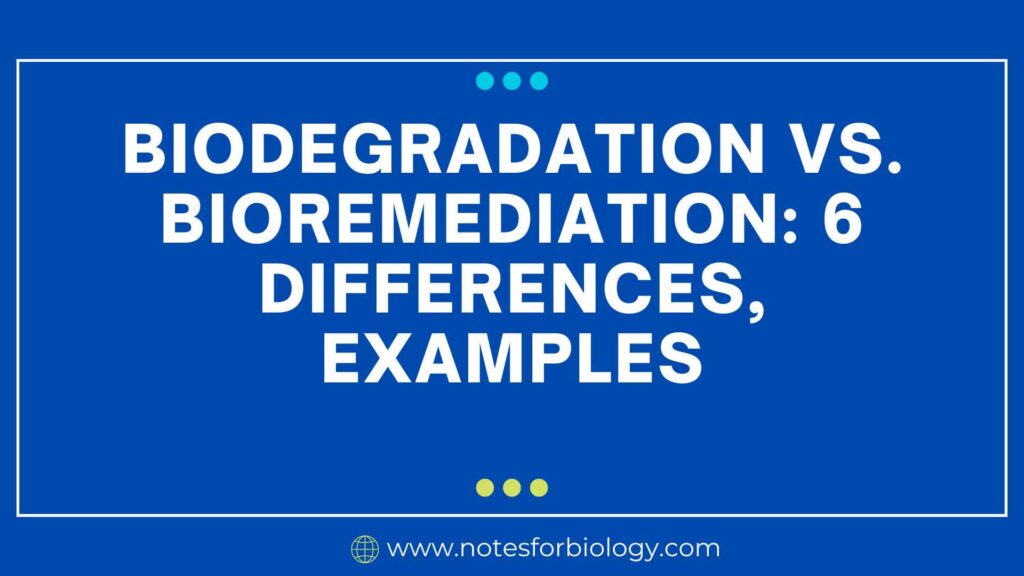Bioremediation is the use of microbes, plants, or microbial or plant enzymes to detoxify environmental pollutants. There are two types : in situ and ex situ. Each has its own approach, advantages, and limitations. The choice between them depends on the specific circumstances of the contamination, including the type and extent of pollutants, site conditions, and economic considerations. In situ methods are cost-effective and less disruptive but slower and less controllable. Ex situ methods offer greater control and faster results but are more expensive and disruptive. Understanding the strengths and limitations of each method allows for informed decision-making in the development of effective strategies.
Table of Contents
Bioremediation
Bioremediation is a process that uses microorganisms, plants, or microbial or plant enzymes to detoxify contaminants in the environment. There are two main types : in situ and ex situ. Each has its own methods, advantages, and disadvantages. The choice between them depends on the specific circumstances of the contamination, including the type and extent of pollutants, site conditions, and economic considerations. In situ methods are cost-effective and less disruptive but slower and less controllable.

In Situ Bioremediation
In situ involves treating the contaminated material at the site. This method is generally preferred for its lower cost and minimal disturbance to the environment.

Methods:
- By using wells to deliver nutrients and air, bioventing encourages the growth of naturally occurring bacteria that break down organic pollutants.
- By injecting air under pressure below the water table, a process known as “biosparging” can raise groundwater oxygen concentrations and speed up the biological breakdown of pollutants.
- In order to improve the biodegradation of pollutants, bioaugmentation entails the introduction of particular bacterial strains or microbial consortia to the site.
Benefits
- Minimal disruption to the location.
- More affordable than ex situ techniques.
- Enhancement of natural attenuation processes is possible.
Drawbacks:
- Restricted to locations where microbial activity is suited.
- Slower than with some ex situ techniques.
- less authority over the procedure.
Ex Situ Bioremediation
Ex situ involves the removal of the contaminated material to be treated elsewhere. This can be done either on-site or off-site.

Methods:
- Biopiles: To encourage microbial activity, contaminated soil is piled and treated with aeration and occasionally fertilizer addition.
- Windrow Composting: To encourage microbial breakdown and aeration, contaminated soil is combined with organic additives and spun on a regular basis.
- Bioreactors: To increase the rate of decomposition, contaminated material is placed in a reactor vessel with carefully controlled conditions.
Benefits
- More command over the surroundings.
- Possibly a quicker process for remediation.
- Capable of efficiently treating a broad variety of pollutants.
Drawbacks:
- More costly because excavation and material transportation are required.
- Increased disruption of the environment.
- Needs room to accommodate treatment facilities.
Comparison and Selection
The choice between in situ and ex situ depends on several factors, including the type and concentration of contaminants, site conditions, cost considerations, and time constraints. In situ methods are generally preferred for large-scale contamination where disturbance to the site must be minimized, while ex situ methods are suitable for highly contaminated sites where rapid and controlled treatment is necessary.
Frequently Asked Question
What is Bioremediation ?
It is a process that uses microorganisms, plants, or microbial or plant enzymes to detoxify contaminants in the environment. There are two main types of it : in situ and ex situ.
What are the three types of bioremediation?
Bioremediation can be classified into three primary types: microbial bioremediation, phytoremediation, and mycoremediation.
Which is an example of bioremediation?
An example of bioremediation is the cleanup of an oil spill using microbial bioremediation techniques. In this process, specific strains of bacteria that can metabolize hydrocarbons are introduced to the contaminated area.
Related Article


